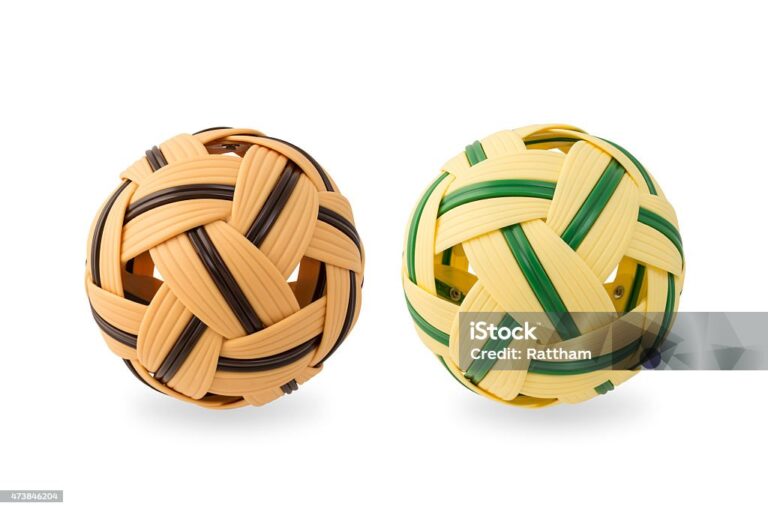What is the Significance of the Holes And Intersections in the Sepak Takraw Ball Design?: Unveiling the Mystery
( If you purchase through our sponsored links, we may receive a small commission at no extra cost to you )
The holes and intersections in a Sepak Takraw ball reduce wind resistance and improve grip. They facilitate better ball control and allow intricate maneuvers during play.
Sepak Takraw, a dynamic sport akin to volleyball, features a unique ball that is both functional and artful in design. Its woven structure, characterized by multiple holes and intersections, directly impacts gameplay efficiency. These features make it less resistant to air, which helps it travel faster and more predictably during high-speed rallies.
They also create a surface that players can grip and manipulate with their feet, knees, chest, or head, allowing for a vast array of strategic moves and serves. Lightness and strength define the ball’s construction, balancing aerodynamics with durability – essential qualities for a sport that is as much about flair as it is about athleticism. Understanding the significance of the ball’s design is crucial for anyone interested in mastering or just appreciating the complexities of Sepak Takraw.

Credit: issuu.com
Introduction To Sepak Takraw
Sepak Takraw combines volleyball, soccer, and gymnastics. Only your feet, chest, head, and knees are used. A rattan ball moves through the air, showcasing captivating acrobatics. This sport charms crowds with its delicate intersections and holes within the ball’s design.
History And Origin Of Sepak Takraw
Sepak Takraw’s roots trace back to the 15th century in Southeast Asia. Originally called ‘Sepak Raga’, it was beloved in royal courts and villages alike. The modern name means ‘kick ball’ in Malay and Thai.
- Originated in Malay-Thai Peninsula
- Adopted net and rules in the 1940s
- Official rules in 1960 for competitions
Basic Rules And Gameplay Of Sepak Takraw
Sepak Takraw has simple rules. The team serves from the back and tries to score. Teams have three touches before the ball must cross over the net.
- The ball must go over the net within three touches
- Touches include chest, head, and feet only
- Points are to 21; Best of two or three sets
In the following sections, we will delve deeper into the significance of the unique ball design and the thrilling gameplay that defines Sepak Takraw.
The Anatomy Of The Sepak Takraw Ball
The intricate design of the Sepak Takraw ball is vital to the game. The distinct pattern of holes and intersections create a unique piece of sports equipment. Each aspect of its design serves a specific purpose, impacting the ball’s movement and players’ performance. Delving into the Sepak Takraw ball’s anatomy reveals the ingenuity behind this traditional Asian sport.
Material And Construction
The Sepak Takraw ball once used natural rattan. Today, synthetic materials like plastic are more common. These materials provide durability and weather resistance, essential for the game’s fast-paced nature.
- Synthetic balls maintain shape better.
- Rattan balls offer a traditional feel.
Traditional And Modern Design Features
Traditional Sepak Takraw balls had simple woven patterns. Modern design incorporates a matrix of interwoven synthetic fibers. This structure ensures the ball is light and able to fly freely.
| Feature | Traditional | Modern |
|---|---|---|
| Material | Rattan | Plastic/Synthetic |
| Design | Simple weave | Interwoven matrix |
| Weight | Varies | Regulated |
Advanced techniques now allow detailed and precise ball designs enhancing performance and aesthetics.
Regulations And Standard Measurements
For official games, ball specifications are strict. The International Sepak Takraw Federation (ISTAF) dictates the size, weight, and design of the balls used in competition.
- Balls must have 12 holes and 20 intersections.
- They must weigh between 170 to 180 grams.
- The circumference should range from 42 to 44 centimeters.
Consistent ball specifications assure a level playing field for competitors.
Significance Of The Ball’s Design
Exploring the fascinating world of Sepak Takraw, the ball holds many secrets. Its unique design is not just for show. Every aspect of the Sepak Takraw ball serves a purpose, from the way it moves through the air to how it responds to a player’s kick. The precise design significantly impacts the game’s pace and style.
The Purpose Of The Holes In The Ball
The Sepak Takraw ball’s holes are more than eye-catching features. They let air pass through, creating a distinctive flight pattern. Players rely on this for consistency during play. The holes also make the ball lighter and easier to control, essential for swift and precise movements in the game.
Intersections: Ensuring Durability And Flexibility
The intersections in a Sepak Takraw ball aren’t accidental. Each crossing point reinforces the ball’s structure. This clever design balances flexibility with toughness. The intersections allow the ball to absorb powerful kicks while maintaining its shape, even after intense gameplay.
Impact On The Ball’s Aerodynamics And Player Performance
Aerodynamics play a crucial role in Sepak Takraw. The holes and intersections affect how the ball spins and moves in the air.
- Easier to predict: The design stabilizes the ball’s flight, helping players anticipate its path.
- Faster reaction times: Consistent aerodynamics lets players react quickly, a must in a fast-paced game.
- Enhanced performance: Players can perform complex maneuvers, thanks to the ball’s predictability and responsiveness.
Understanding the design’s impact can give players a competitive edge.
Cultural And Symbolic Aspects
The intricacies of the sepak takraw ball are not merely for aesthetics. They hold deep cultural significance. Across Southeast Asia, this uniquely woven ball is more than sports equipment. It is a testament to tradition and regional identity. Let’s delve into the symbolism sewn into every twist and turn of its design.
The Ball Design As A Symbol Of Heritage
The sepak takraw ball stands as a beacon of heritage. Each woven pattern echoes the skill and craftsmanship passed through generations. Symbolically, it reflects unity — a series of interconnected strands coming together to form a complete, robust sphere. This aspect of design mirrors the community spirit prevalent in the game’s history.
Influence On Regional Variations Of The Game
Sepak takraw thrives on diversity. From village to village, the ball’s design varies, often signifying the unique features of a local area. These variations are not just visual. They can influence the way the game plays out. A tighter weave leads to a faster game, while a looser weave makes for a different pace. Thus, the ball’s design has a direct link to the style of play, further enriching the cultural tapestry of the game.
Technical And Scientific Perspectives
Welcome to the exploration of Sepak Takraw ball design through a technical lens. This design is not just a matter of aesthetics. It has deep-rooted significance in the way the game is played and the performance of the players.
Understanding the holes and intersections in a Sepak Takraw ball reveals a marriage of cultural tradition and advanced science. Let’s dive into the complex world of material science, ball movement dynamics, and future innovation in design.
Insights From Material Science
Material science plays a pivotal role in Sepak Takraw ball design. Each aspect is engineered for resilience and flexibility.
- Durable synthetic fibers to withstand kicks
- Lightweight for high-flying acrobatics
- Interwoven patterns for optimal grip
The ball’s integrity relies on its unique structure. The holes are integral for flexibility, allowing the ball to resume shape rapidly after being struck.
Studies On Ball Movement And Dynamics
Movement studies have shown that the ball’s aerodynamics is largely affected by its distinctive design.
- Smoother trajectory for precise control
- Reduced wind resistance for faster gameplay
- Intersections provide unpredictable spins
These characteristics ensure that Sepak Takraw remains a fast-paced and engaging sport that rewards skill and agility.
Innovations And Future Development
Design innovations continue to shape Sepak Takraw. Advancements in 3D printing and materials may lead to even more effective ball designs. Future developments could optimize ball performance even further, making the game more exciting and competitive.
- Exploration of new materials for enhanced durability
- Enhanced design for improved aerodynamics
- Technological integration for player performance tracking
These potential advancements indicate a bright future for the sport and its equipment.

Credit: issuu.com

Credit: www.yumpu.com
Frequently Asked Questions Of What Is The Significance Of The Holes And Intersections In The Sepak Takraw Ball Design?
Why Are There Holes In A Sepak Takraw Ball?
The holes in a Sepak Takraw ball reduce air resistance, allowing smoother flight. They also enhance grip and control for the players. This unique design makes the ball lightweight and allows for precise maneuvers during play.
How Does Ball Design Influence Sepak Takraw Gameplay?
The ball’s distinctive pattern of holes and intersections ensures consistent aerodynamics. This design allows players to perform complex kicks, spins, and strikes with accuracy. The lighter weight also results in fast-paced and agile gameplay.
What Materials Are Used In Sepak Takraw Ball Construction?
Sepak Takraw balls are traditionally made from rattan, providing flexibility and durability. Modern balls might use synthetic materials like plastic to offer uniformity in size, weight, and bounce, without compromising on resilience.
Does Ball Design Affect Sepak Takraw Ball’s Durability?
Yes, the interwoven pattern with holes provides structural integrity that resists deformation. This increases the ball’s lifespan despite the high-impact nature of Sepak Takraw. Quality materials contribute to this durability as well.
Conclusion
Understanding the design intricacies of the Sepak Takraw ball reveals its impact on gameplay and player performance. The holes and intersections are not merely aesthetic; they are pivotal in ensuring the ball’s aerodynamic qualities and durability. As players and enthusiasts, appreciating these elements can deepen our respect for the sport and its equipment, highlighting the thoughtful engineering behind a game loved by many.



